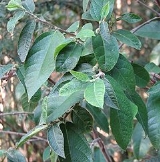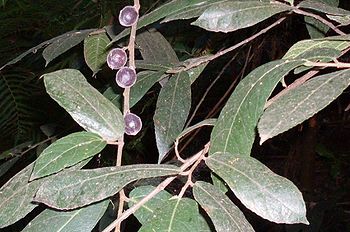
Ficus coronata
Encyclopedia
Ficus coronata, commonly known as the Sandpaper Fig or Creek Sandpaper Fig, is a species of fig
tree, native to Australia
. It is found along the east coast from Mackay
in Central Queensland
, through New South Wales
and just into Victoria
near Mallacoota. It grows along river banks and gullies in rainforest and open forest. Its common name is derived from its rough sandpapery leaves, which it shares with the other sandpaper fig
s.
coronata "crowned", referring to a ring of bristles around the apex of the fruit. Ficus stephanocarpa (also meaning ‘crowned fruit’) as described by the German botanist Otto Warburg
is a synonym.
on the upper side. The new growth is hairy. The succulent oval fruit is around 1.5 cm (0.6 in) long and covered in dense hairs.
). It is found from Mackay
southwards through New South Wales and into eastern Victoria where it is listed as "threatened" under the Flora and Fauna Guarantee Act 1988. There is one record from the Northern Territory.
(Sphecotheres vieilloti), Green Catbird
(Ailuroedus crassirostris), Olive-backed Oriole
(Oriolus sagittatus), Topknot Pigeon
(Lopholaimus antarcticus), and Grey-headed Flying Fox
(Pteropus poliocephalus) are among those animals who consume the fruit.

A popular story holds that the fig's leaves were used as sandpaper for polishing wood or turtle shells by indigenous people, yet when tested by Bonsai and fig enthusiast Len Webber, they were too brittle and soft to function in this fashion.
The Sandpaper Fig's leaves are an attractive attribute which may be highlighted with bonsai
, although the trunk may not thicken spontaneously. It is suited to a shady position in gardens, or medium to brightly-lit indoor spaces. Like all figs in garden situations, they attract birds, such as species of silvereye
and rainforest pigeon.
Ficus
Ficus is a genus of about 850 species of woody trees, shrubs, vines, epiphytes, and hemiepiphyte in the family Moraceae. Collectively known as fig trees or figs, they are native throughout the tropics with a few species extending into the semi-warm temperate zone. The Common Fig Ficus is a genus of...
tree, native to Australia
Australia
Australia , officially the Commonwealth of Australia, is a country in the Southern Hemisphere comprising the mainland of the Australian continent, the island of Tasmania, and numerous smaller islands in the Indian and Pacific Oceans. It is the world's sixth-largest country by total area...
. It is found along the east coast from Mackay
Mackay, Queensland
Mackay is a city on the eastern coast of Queensland, Australia, about north of Brisbane, on the Pioneer River. Mackay is nicknamed the sugar capital of Australia because its region produces more than a third of Australia's cane sugar....
in Central Queensland
Central Queensland
Central Queensland is an ambiguous geographical division of Queensland that centres on the eastern coast, around the Tropic of Capricorn. Its major regional centre is Rockhampton and the Capricorn Coast and the area extends west to the Central Highlands at Emerald, north to the Mackay Regional...
, through New South Wales
New South Wales
New South Wales is a state of :Australia, located in the east of the country. It is bordered by Queensland, Victoria and South Australia to the north, south and west respectively. To the east, the state is bordered by the Tasman Sea, which forms part of the Pacific Ocean. New South Wales...
and just into Victoria
Victoria (Australia)
Victoria is the second most populous state in Australia. Geographically the smallest mainland state, Victoria is bordered by New South Wales, South Australia, and Tasmania on Boundary Islet to the north, west and south respectively....
near Mallacoota. It grows along river banks and gullies in rainforest and open forest. Its common name is derived from its rough sandpapery leaves, which it shares with the other sandpaper fig
Sandpaper Fig
The Sandpaper Figs are so named for their leaves, which are rough and sandpaper-like in texture. The common name may refer to a number of species:*Ficus coronata*Ficus coronulata*Ficus fraseri*Ficus opposita*Ficus scobina...
s.
Taxonomy
It was first described by the Italian Marquese di Spigno in 1818. Its specific epithet the LatinLatin
Latin is an Italic language originally spoken in Latium and Ancient Rome. It, along with most European languages, is a descendant of the ancient Proto-Indo-European language. Although it is considered a dead language, a number of scholars and members of the Christian clergy speak it fluently, and...
coronata "crowned", referring to a ring of bristles around the apex of the fruit. Ficus stephanocarpa (also meaning ‘crowned fruit’) as described by the German botanist Otto Warburg
Otto Warburg (botanist)
Otto Warburg , was a German botanist and industrial agriculture expert, as well as an active member of the Zionist Organization...
is a synonym.
Description
The sandpaper fig is a small tree which may reach the dimensions of 6–12 m (20–40 ft) tall by 3–5 m (10–15 ft) wide, although is generally smaller. The trunk is dark brown, and the ovate or elliptical leaves are 5–15 cm (2–6 in) long by 2–5 cm (1–2 in) wide and very scabrous (rough) like sandpaperSandpaper
Sandpaper, also known as glasspaper, is a heavy paper with abrasive material attached to its surface.Sandpaper is part of the "coated abrasives" family of abrasive products. It is used to remove small amounts of material from surfaces, either to make them smoother , to remove a layer of material...
on the upper side. The new growth is hairy. The succulent oval fruit is around 1.5 cm (0.6 in) long and covered in dense hairs.
Distribution and habitat
The Sandpaper fig is found along watercourses and gullies in rainforest, and less commonly in open forest. It may be associated with the rough-barked apple (Angophora floribundaAngophora floribunda
Angophora floribunda is a common woodland and forest tree of Eastern Australia and is known by a variety of names including Rough-barked apple, Apple box, Rusty gum, and Boondah....
). It is found from Mackay
Mackay, Queensland
Mackay is a city on the eastern coast of Queensland, Australia, about north of Brisbane, on the Pioneer River. Mackay is nicknamed the sugar capital of Australia because its region produces more than a third of Australia's cane sugar....
southwards through New South Wales and into eastern Victoria where it is listed as "threatened" under the Flora and Fauna Guarantee Act 1988. There is one record from the Northern Territory.
Ecology
Ficus coronata serves as a food plant for the caterpillars of the Queensland butterfly the Common- or Purple Moonbeam (Philiris innotatus), The Australasian FigbirdAustralasian Figbird
The Australasian Figbird is a conspicuous medium-sized passerine bird native to a wide range of wooded habitats in northern and eastern Australia, southern Papua New Guinea, and the Kai Islands in Indonesia. It was formerly considered a subspecies of S...
(Sphecotheres vieilloti), Green Catbird
Green Catbird
The Green Catbird, Ailuroedus crassirostris is a species of bowerbird found on subtropical forests along the east coast of Australia, from southeastern Queensland to southern New South Wales. Its colouring is emerald green, with faint black markings on the face and white streaks on the neck.Green...
(Ailuroedus crassirostris), Olive-backed Oriole
Olive-backed Oriole
The Olive-backed Oriole is a very common medium-sized passerine bird native to northern and eastern Australia and New Guinea. The most wide-ranging of the Australasian orioles, it is noisy and conspicuous. Not bright in colour, it is olive-backed with small dark streaks, with a light chest having...
(Oriolus sagittatus), Topknot Pigeon
Topknot Pigeon
The Topknot Pigeon is a pigeon native to Australia. It is also known by the name of "Flock Pigeon".-Description:...
(Lopholaimus antarcticus), and Grey-headed Flying Fox
Grey-headed Flying Fox
The Grey-headed Flying-Fox, Pteropus poliocephalus, is a megabat native to Australia.Members of the genus Pteropus include the largest bats in the world. The Pteropus genus has currently about 57 recognised species....
(Pteropus poliocephalus) are among those animals who consume the fruit.

Uses
The fruit is edible and palatable, and was consumed by local aborigines.A popular story holds that the fig's leaves were used as sandpaper for polishing wood or turtle shells by indigenous people, yet when tested by Bonsai and fig enthusiast Len Webber, they were too brittle and soft to function in this fashion.
The Sandpaper Fig's leaves are an attractive attribute which may be highlighted with bonsai
Bonsai
is a Japanese art form using miniature trees grown in containers. Similar practices exist in other cultures, including the Chinese tradition of penjing from which the art originated, and the miniature living landscapes of Vietnamese hòn non bộ...
, although the trunk may not thicken spontaneously. It is suited to a shady position in gardens, or medium to brightly-lit indoor spaces. Like all figs in garden situations, they attract birds, such as species of silvereye
Zosterops
Zosterops is a genus of birds containing the typical white-eyes. They are traditionally placed in the white-eye family, Zosteropidae, which may actually be a part of the Timaliidae, however...
and rainforest pigeon.

